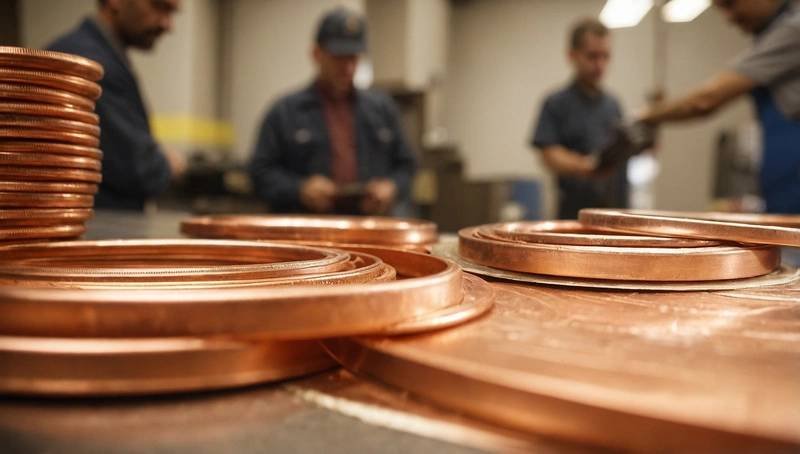Copper price surge has grabbed global headlines after jumping 13% in just a few days, triggered by newly imposed tariffs on Chinese imports. This sharp rise is causing growing inflation concerns worldwide, as industries reliant on copper—from construction to electronics—face higher production costs and increased uncertainty.
The sudden increase in this essential metal’s price reflects more than just supply chain disruption. It signals renewed tensions between the U.S. and China and raises fears of a broader economic impact. Investors, businesses, and policymakers are now scrambling to assess how this surge will affect global inflation trends and consumer prices.
Why Did Copper Prices Surge?
The recent copper price surge can be largely attributed to the announcement of new tariffs imposed by the U.S. government on Chinese imports, including metals and raw materials critical to manufacturing. In response, China hinted at retaliatory measures, further intensifying trade tensions between the world’s two largest economies.
Here’s a quick summary of the developments:
- Tariffs imposed: The U.S. imposed additional tariffs on a wide range of Chinese goods, including critical raw materials such as rare earths and base metals like copper.
- Market reaction: Investors anticipated supply disruptions and higher production costs, leading to increased buying activity and a sharp price spike.
- Supply concerns: Traders fear that China may restrict exports or increase domestic stockpiling of copper, which would tighten global supply.
The combination of tariff tension, supply disruption, and speculative buying led to copper prices rising by 13% in just a few trading sessions—one of the largest short-term jumps in recent years.
What Do the New Tariffs Mean?
The new set of tariffs targets Chinese imports worth billions of dollars, with copper and other industrial materials at the heart of the dispute. While these tariffs aim to protect domestic manufacturing and reduce reliance on Chinese goods, they come with significant trade-offs.
Key implications of the tariffs:
- Higher import costs: U.S. manufacturers will now pay more for copper sourced from China, making end-products more expensive.
- Global price pressure: As buyers look for alternative sources, the demand shifts to other copper-exporting countries, driving up prices globally.
- Retaliation risk: China could impose its own restrictions or tariffs, exacerbating the trade conflict.
These policy changes don’t just impact the U.S. and China. Since copper is traded globally, any major disruption in one part of the supply chain sends shockwaves throughout the world economy.
How the Copper Price Surge Impacts Inflation

The spike in copper prices couldn’t have come at a worse time. Many economies are still grappling with post-pandemic inflation and trying to rein in price growth without triggering recessions. Now, the added pressure from rising commodity costs—especially copper—threatens to reignite inflationary trends.
Why copper matters in inflation:
- Broad usage: Copper is a core material in electronics, cars, construction, and energy. A rise in its price affects many sectors at once.
- Input costs rise: Higher copper costs increase manufacturing expenses, which are often passed on to consumers.
- Energy transition: Copper is crucial for green technologies like EVs and solar panels. As the world accelerates its energy transition, demand for copper remains high, limiting the possibility of price relief.
The recent surge could push consumer prices higher, especially for goods that heavily rely on copper wiring, components, or construction materials.
Industries Hit Hardest by the Price Hike
While the entire economy may feel the effects of rising copper prices, some sectors are particularly vulnerable.
1. Electronics Manufacturing
- Smartphones, laptops, and household appliances use copper in circuit boards and wiring.
- A price surge will likely increase production costs, possibly reducing profit margins or leading to price hikes for consumers.
2. Automobile Sector
- Modern vehicles use between 40 and 80 pounds of copper.
- Electric vehicles (EVs) require even more—up to 180 pounds per car.
- Automakers could see a notable increase in material costs, which might slow down production or raise car prices.
3. Construction and Infrastructure
- Copper is widely used in plumbing, wiring, and roofing.
- New construction projects and government-funded infrastructure may become more expensive, potentially delaying developments.
4. Green Energy Sector
- Renewable energy systems like wind turbines, solar panels, and EV charging stations heavily depend on copper.
- Rising copper costs could slow down clean energy transitions or increase the cost of green tech.
The Role of Speculation in the Copper Price Surge
While tariffs were the main catalyst, market speculation amplified the copper price surge. Traders often view metals like copper as hedges against inflation. When news of tariffs broke, speculative buying picked up pace as investors sought to profit from the anticipated supply shock.
In addition, hedge funds and institutional traders poured money into copper futures, further driving prices up.
This kind of momentum-based buying is not uncommon in the commodities market, but it adds volatility and can sometimes inflate prices beyond reasonable levels—causing further market distortion.
What Experts Are Saying
Analysts and economists have weighed in with a range of perspectives on the situation.
Jane Morris, Senior Economist at GlobalCommodities, stated:
“This copper price surge highlights how fragile global supply chains remain. Any disruption, especially from geopolitical tensions, can lead to runaway inflation risks.”
David Klein, a commodities analyst, noted:
“We’re seeing a classic inflationary loop—tariffs increase input costs, markets overreact, prices jump, and the end consumer feels the pinch.”
Many experts believe central banks will closely watch these developments. If copper-driven inflation spreads, it may force interest rates to stay higher for longer, affecting borrowing costs and economic recovery plans.
What Can Be Done to Ease the Pressure?

Several steps could be taken by governments and industries to soften the blow of the copper price surge:
1. Diplomatic Negotiations
- De-escalating trade tensions between the U.S. and China could restore confidence and ease market fears.
- Avoiding retaliatory tariffs would stabilize copper prices.
2. Diversifying Supply Chains
- Companies can reduce their dependence on Chinese copper by sourcing from other countries like Chile, Peru, and Congo.
- Encouraging domestic mining and recycling can also help.
3. Strategic Reserves
- Countries may tap into copper stockpiles or build new reserves to stabilize supply and prevent price spikes.
4. Technological Substitutes
- In some applications, aluminum or other materials can replace copper, though not always effectively.
- Investment in such alternatives could reduce long-term pressure on copper demand.
What This Means for You
For the average consumer, the copper price surge could mean:
- Higher prices for electronics and appliances.
- Increased costs for home construction or renovation.
- Rising auto prices, especially for electric vehicles.
- Slower rollout of green energy technologies.
Businesses, especially in manufacturing and construction, may face tighter margins or delays in projects. Long-term contracts might also need to be renegotiated to reflect the new material costs.
Looking Ahead: Will Prices Stay High?
The future of copper prices depends on several unpredictable factors:
- Will the trade war intensify or ease?
- Can supply chains adapt quickly enough to meet demand?
- Will governments step in to regulate or stabilize commodity markets?
If tensions between the U.S. and China persist, copper prices may remain elevated or even rise further. However, if diplomatic efforts succeed, markets could stabilize, and prices might cool off over the coming months.
Regardless, the recent surge is a clear reminder of how interconnected global trade, commodity markets, and inflation are. Even a single policy change—like new tariffs—can have far-reaching consequences across the world economy.
Final Thoughts
The 13% copper price surge is more than just a market headline—it’s a warning sign. With global economies still recovering, this sudden shock threatens to derail progress and rekindle inflation concerns. As policymakers weigh their next moves and companies scramble to manage costs, consumers should prepare for the ripple effects to touch many areas of daily life.
Read Next – Court Battles Over Liberation Day Tariff Orders: What’s at Stake?






